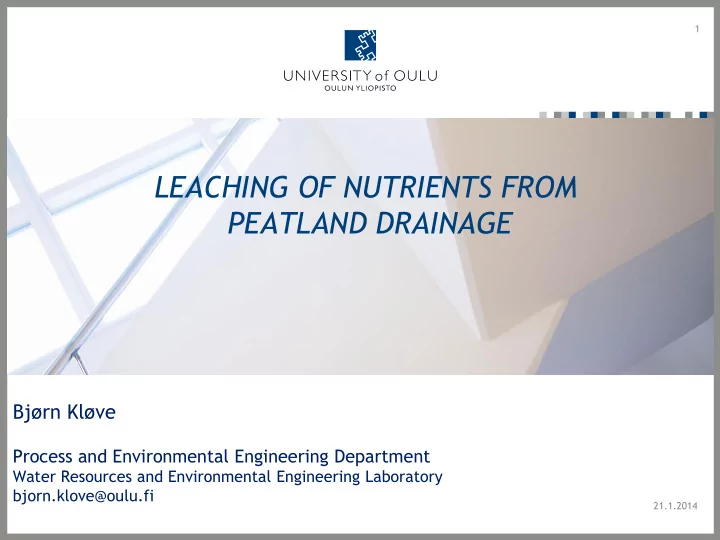

1 LEACHING OF NUTRIENTS FROM PEATLAND DRAINAGE Bjørn Kløve Process and Environmental Engineering Department Water Resources and Environmental Engineering Laboratory bjorn.klove@oulu.fi 21.1.2014
2 CONTENT • Leaching from different peatland uses and peat soil characteristics • P leaching • N leaching • Hydrological controls • Drainage depth • Rainfall/snowmelt generated runoff 21.1.2014
3 Land cover typically consist of forests and peatlands , so water are often brown and humic! 21.1.2014
4 WATER QUALITY AND ORGANIC SOILS • Water tends to be brown in color due to humic substances • Varies based on hydrology, land use, peat type, soil types etc 21.1.2014
PEAT SOILS: ACCUMULATION • Several compounds have been accumulated in peat due to plant growth and past geochemical environment (e.g. precipitation of Fe) catchment and groundwater properties • Peat soils will have different content of Fe, P, metals etc. • N? C? • What happens after drainage?
How does drainage influence leaching? P , N, Fe, metals humic substances?
Peat harvesting Leaching influenced by: Soil type Drainage depth Local climate Hydrology (temporal variation) Björn Klöve, 19.4.2012
SUB SOIL INFLUENCE • Sub soil influence water quality • Erosion and SS transport • Acide sulphide soils
9 PEATLAND CULTIVATION AND LEACHING On cultivated soils Good yield, high ET , low runoff, less • leaching Nutrients updtake by plants important • Manure should not be applied • 21.1.2014
10 LEACHING Pristine Drained Nutrient uptake Areation of peat, release of Some leaching nutriens flow patterns also from deep peat runoff and flooding release nutrients 21.1.2014
P 11 • High variation between sites in soil natural P and P leaching potential after drainage • P fertilization will result in P accumulation in top soil layers • P loads temporal variation • high with low runoff from unfertilized peatlands • Increase with runoff from cultivated sites? • As from cultivated mineral soils? 21.1.2014
FE AND P IN DIFFERENT PEATLAND USES AT PELSO 3,00 3,00 Total Al Total P 2,50 2,50 2,00 2,00 kg / m3 1,50 1,50 1,00 1,00 0,50 0,50 0,00 0,00 0-15 45-60 0-15 45-60 Depth (cm) Depth (cm) Hyvärinen, Mustamo, Ronkanen ja Klöve 2012 julkaisematon aineisto 7,00 Total Fe 7,00 Total Ca 6,00 6,00 5,00 5,00 kg / m 3 4,00 4,00 3,00 3,00 Cultivated peatland 2,00 Peat extraction 2,00 1,00 Peatland forest 1,00 Pristine bog 0,00 0,00 0-15 45-60 0-15 45-60 Depth (cm) Depth (cm)
PHOSPHOROUS LEACHING • P depends on soil and land use (fertiilization) • LAND USE EFFECTS: • Cultivated sites: high P with runoff • Cutover peatlands: high P in low flow Kløve, B. 2001. Characteristics of nitrogen and phosphorus loads in peat mining wastewater. Water Research 35 (10), 2353-2362. Björn Klöve, 19.4.2012
14 P LEACHING: PEAT HARVESTING 1.6 0.3 1.4 0.25 1.2 PO4-P in (mg/l) Ptot in (mg/l) 0.2 1 0.8 0.15 0.6 0.1 0.4 0.05 0.2 0 0 0 100 200 300 400 500 600 700 0 100 200 300 400 500 600 700 Q (l/s) Q (l/s) 21.1.2014
PO4-P AND DRAINAGE DEPTH: PEAT HARVESTING 0.09 0.08 R 2 = 0.3557 PO4-P in (mg/l) 0.07 0.06 0.05 0.04 0.03 0.02 0.01 0 0 20 40 60 80 100 120 Ojitussyvyys (cm) Björn Klöve, 19.4.2012
16 P rich soils due to deposition as P-Fe Vivianite - High variation between sites Fe(PO4)2 Fe3(Po4)2 · 8H2 21.1.2014 2[Fe3(PO4)2 · 8H2O]
N N leaching • N released from peat • N added as fertilizers • N surplus and N in soil can leach Peat harvesting: N leached as NH4-N and Org- N and occasionally as NO3-N • N leaching depends of drainage, high on newly drained sites • Difference between sites probably smaller than with P leaching Björn Klöve, 19.4.2012
N – PEAT HARVESTING Björn Klöve, 19.4.2012
19 LEACHING AND RUNOFF: PEAT HARVEST. ET P P arable land NO3 ” old water ” P from PH • P high in old water rich in humus substances (peat harvesting= • P probably high in runoff after cultivation • NO3-N high in areated layers and released in high runoff events 21.1.2014
Snowmelt and leaching KIITOS Runoff through soil or not? Björn Klöve, 19.4.2012
21 HYDROLOGICAL PATHWAYS STUDIES 21.1.2014 Riku Eskelinen
22 SNOW, FROST AND SNOWMELT 21.1.2014
23 CONCLUSION FROM SNOW MELT RUNOFF STUDIES Overland flow Low K, as water freezes • Snowmelt runoff, if soil is frozed, result in overland flow and low nutrient concentration in runoff 21.1.2014
24 LEACHING HYDROLOGY • Drained site deep peat Inundated • Drained shallow peat Sesonally flooded 21.1.2014
25 LEACHING OF NUTRIENTS: SUMMARY • Variation between catchments due to variation in land use, soil properties and to some extent climate • On cultivated soils • good yield, hihgh ET, low runoff, little leaching • Nutrients updtake by plants • High temporal variation of nutrient leaching due to interaction between climate-hydrology-soils-geochemistry- vegetation interaction Björn Klöve, 19.4.2012
26 Thank you for attention Acknoweldgements • PhD researchers and other staff Recent funders: MMM, Vapo Oy, MVTT , Nesssling, EU-EAKR programme etc. • 21.1.2014
27 WHY IMPORTANT TO KNOW ABOUT LACHING PROCESSES • Nutrient input in surface waters can result in reduced water quality • When to reduce loading? • Characteristics of loading must be known for efficient removal • Drainage influence P, N, metals and water pH • Environmental aspects in management options should consider leaching 21.1.2014
28 DRAINAGE • Catchemnt runoff cut-off and nutrients not trapped in peatlands • Changes in hydrology, water chemistry, vegetation if left alone • Intense land use after drainage • Water transport throught decomposed soils • Soils areated • Organic matter decay • pH increased • Excepts on AS soils • Sub soil influence • ph, metals 21.1.2014 • Erosion
Recommend
More recommend